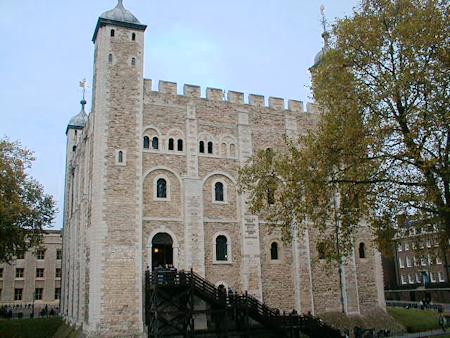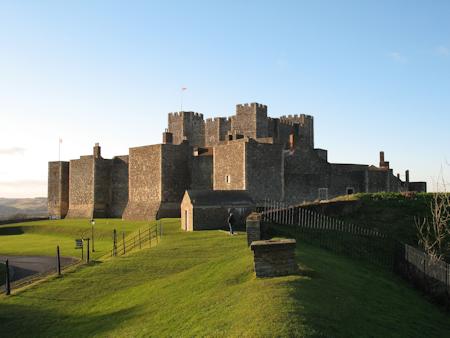
Castles in England
The first castles were built in England just after the Norman invasion in 1066. There were probably a few earlier structures that served as fortified houses, but it was the Normans who really needed proper military castles. They were foreigners in a warlike land and with only a relatively small invasion force they needed a way to defend themselves and keep the local populace under control. Castles were ideal for this task.
William the Conqueror was crowned on Christmas Day 1066 and immediately started to build a castle. It was probably on the site where he later constructed the Tower of London. He and his principal followers spread out over the country taking over estates and earldoms and planting castles to hold the country.

White Tower at the Tower of London
First English Castles
The first castles were simple wooden affairs, rapidly constructed and using either natural strong points or artificial mounds with wooden stockades and buildings. As the Normans gradually became more settled in their lands these castles were converted to stronger stone fortifications.
The stone castles were considerably more expensive and time-consuming to build. The owners were also increasingly concerned with the comforts within the castle and making sure that the castle properly reflected their status and wealth. An example of this being the use of Caen stone. The stone was considered both beautiful and high enough quality to be used in castles. It was, however, enormously expensive as it had to be imported from Normandy. Notable examples of its use include Arundel Castle, Norwich Castle and, of course, the Tower of London.
During the 14th and 15th Centuries castles still looked formidable on the outside, but were becoming quite domesticated on the inside. The great hall of many castles were converted and adapted with large windows facing into a central courtyard. The other essential domestic buildings (cellars, kitchens, ovens, servant's quarters etc) were contained within the castles defensive structures and strong walls.

Looking up at Norwich Castle
Castles defences were constantly evolving during this time too. Square keeps gave way to rounded towers which better deflected incoming fire. Walls became thicker and buttressed and moats were added to make undermining them a lengthier operation and a much riskier proposition. Castles were also being adapted in the 15th and 16th Centuries to allow gun emplacements. New constructions were being designed specifically with guns in mind. Arrow slits were replaced with gun ports and new openings were being added to allow cannons to fire out on attackers.
Later English Castles
Castles came back into their own again in England during the Civil War in the 17th Century. A great many castles were either destroyed or slighted by both sides during this period as they fought for control of the country. Castle design was evolving rapidly during this time as more powerful cannon and field artillery came into use. The Norman castle design with its high walls and central keep proved to be a sitting target for cannon fire.
The castles and fortifications built around this time were designed specifically with powerful artillery in mind. The towers were low with very thick rounded walls and designed to serve as platforms for heavy guns. Lighter guns could also be placed in the towers.
The last great fortifications built in England were constructed in the 1860s all around the coast to guard both the coastline and various strategic ports. The final change to castles in England occurred during the Second World War with the addition of pillboxes to many of the castle sites. The castles, after all, were placed in excellent strategic locations over the centuries and they just needed adaptation to the warfare of the time.

Dover Castle
List of Castles in England
- Arundel Castle, Arundel, West Sussex
- Bamburgh Castle, Bamburgh, Northumberland
- Bolsover Castle, Bolsover, Derbyshire
- Carlisle Castle, Carlisle, Cumbria
- Castle Rising, Castle Rising, Norfolk
- Chillingham Castle, Chillingham, Northumberland
- Colchester Castle, Colchester, Essex
- Corfe Castle, Wareham, Dorset
- Doddington Castle, Nantwich, Cheshire
- Dover Castle, Dover, Kent
- Ely Castle, Ely, Cambridgeshire
- Greystoke Castle, Penrith, Cumbria
- Haddon Hall, Bakewell, Derbyshire
- Hever Castle, Edenbridge, Kent
- Ince Castle, Saltash, Cornwall
- Kenilworth Castle, Kenilworth, Warwickshire
- Ludlow Castle, Ludlow, Shropshire
- Norwich Castle, Norwich, Norfolk
- Pengersick Castle, Praa Sands, Cornwall
- Peveril Castle, Castleton, Derbyshire
- Rockingham Castle, Market Harborough, Leicestershire
- Rye Castle, Rye, East Sussex
- Skipton Castle, Skipton, North Yorkshire
- Stafford Castle, Stafford, Staffordshire
- Sudeley Castle, Winchcombe, Gloucestershire
- Tamworth Castle, Tamworth, Staffordshire
- Warwick Castle, Warwick, Warwickshire